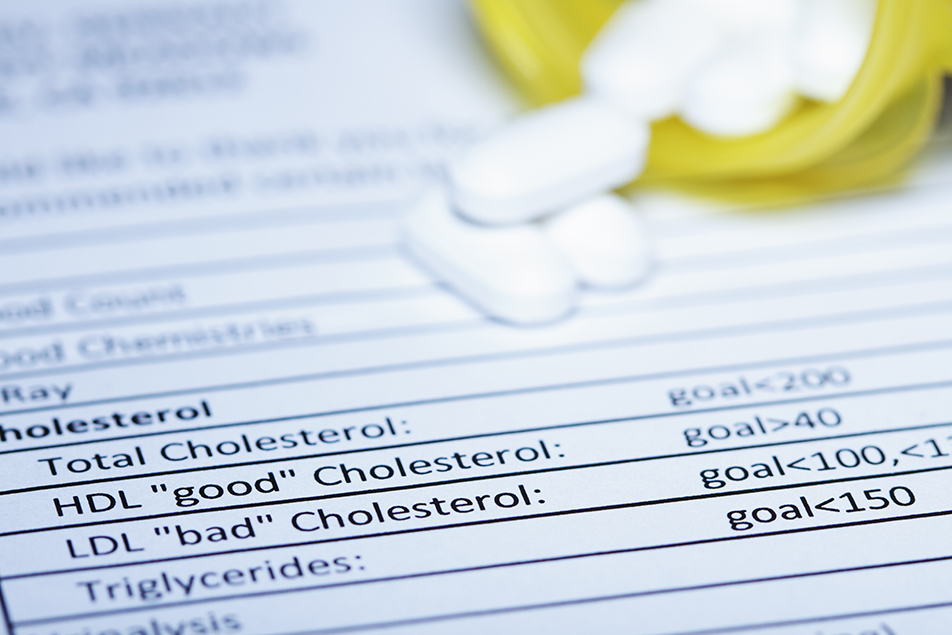
This post was written by Charles Presti, MD, PPG – Cardiology. Read the first in the series, Understanding cholesterol: Part 1.
In 1985, Dr. Joseph Goldstein and Dr. Michael Brown, both working at the University of Texas Health Science Center in Dallas, received the Nobel Prize in Physiology and Medicine for their discovery of the LDL receptor in 1973. Their discovery led to the eventual development of statin drugs to treat patients with elevated cholesterol levels. I had the honor of hearing Dr. Brown and Dr. Goldstein give a lecture in the late 1980s, around the time the first statin drug, Lovastatin, was approved for clinical use. I knew then that this was an important advance in the understanding and potential treatment of atherosclerosis. Still, I had no idea that these medications would become game-changers in treating vascular disease and significantly reduce the risk of heart attacks and cardiovascular deaths.
Since that time, many clinical trials of multiple medications that lower LDL cholesterol involved several hundred thousand patients. So, in part two of this series, let’s take a closer look at the efficacy of these medications and their use in treating patients with, or at risk for, atherosclerotic vascular disease.
Statin drugs
Statin drugs reduce LDL cholesterol by inhibiting the production of it in the liver. In response to this decreased production, the liver increases the number of LDL receptors on its surface, increasing LDL removal from the blood. Statins generally result in about a 30-50% reduction in LDL cholesterol depending on the prescribed statin, the dose of the drug and LDL level before treatment. Since their development, multiple clinical trials have consistently demonstrated that treatment of dyslipidemic patients, with and without established vascular disease, with statins, results in a reduction in major cardiovascular events.
One of the more interesting findings in all these studies is that the benefits of statins appear to be due to more than just the result of lowering LDL cholesterol. The benefits of statin therapy in patients who have had a recent heart attack occur very early, within a few weeks, which is sooner than expected from lowering LDL alone. Additionally, multiple studies have shown that statin therapy can significantly reduce the risks of heart attack and stroke, even in individuals with “normal” or low cholesterol values. Many believe there are multiple potential mechanisms that statins may work, over and above their cholesterol-lowering properties, to cause these results. Also, with anti-inflammatory, anti-oxidant and anti-clotting properties, statins help stabilize the atherosclerotic plaques in blood vessels. These properties make them less likely to break open and cause heart attacks. The beneficial effects of statin therapy are likely a combination of all these properties and LDL lowering.
Of course, no medication comes without the risk of side effects, and statins are no different. The most commonly reported side effect with statin therapy is muscle pain or myalgia. However, it is important to keep in mind that muscle aches are common and often explained by factors other than statin therapy. Those patients who have true statin-associated myalgia can manage their condition using a lower dose or switching to a different statin medication. Because statins are so beneficial in reducing the risks of vascular disease, your physician will often try several ways to keep you safely on the therapy.
Non-statin drugs
Now let’s take a moment to examine non-statin drugs, their efficacy and which might pair well with statin drugs to treat those at risk for atherosclerotic vascular disease.
- Ezetimibe: Unlike statin drugs, ezetimibe works by blocking cholesterol absorption in the intestine. Ezetimibe results in about a 15-20% lowering of LDL cholesterol, whether used alone or in combination with statin drugs. Providers prescribe ezetimibe to patients who have unacceptable side effects to statins or do not achieve sufficient lowering of LDL cholesterol from statins alone. One study demonstrated that the addition of ezetimibe to statin therapy resulted in a further reduction in LDL level and an additional reduction in the risk of recurrent cardiovascular events.
- Bempedoic Acid: Bempedoic acid acts on the same pathway in the liver as statins, although at a different step, and results in about a 15-20% reduction in LDL cholesterol, whether used alone or in combination with statins. When combined with ezetimibe, it can result in up to a 40% reduction in LDL. It is a relatively new agent, so no large studies have demonstrated its effects in patients on heart attacks and strokes, but these trials are currently underway. One potential advantage of this agent is that it is not activated in skeletal muscle and therefore does not have a significant incidence of myalgia.
- PCSK9 inhibitors: The development of PCSK9 inhibitors, which stands for proprotein convertase subtilisin-kexin type 9 (you can see why we say PCSK9!), is another fascinating story of the translation of basic scientific research to actual patient care. In 2003, Dr. Nabil Seidah, working at the Montreal Clinical Research Institute, discovered the PCSK9 protein. Around the same time, they figured out the role that PCSK9 plays in LDL metabolism. They found that PCSK9 binds to the LDL receptor after it has picked up LDL from the bloodstream and then “shepherds” it once inside the cell. The LDL receptor then releases its LDL cholesterol to be degraded, and in the absence of PCSK9, the LDL receptor is then “recycled” back to the cell surface where it can pick up more LDL cholesterol. However, in the presence of PCSK9, the LDL receptor is also degraded, thus reducing the number of available receptors on the cell surface. Subsequent collaborative work with a group in Paris, France, showed that in a family with very high LDL cholesterol and premature development of cardiovascular disease, a mutation in the gene that codes for the PCSK9 protein resulted in increased production of PCSK9. As outlined above, they expected this to result in high levels of LDL cholesterol. Shortly after, they found that individuals who had a gene mutation that resulted in the underproduction of PCSK9 had very low LDL cholesterol levels throughout life and a markedly reduced incidence of cardiovascular disease.
This extraordinary combination of scientific and genetic research led to the development of antibodies against PCSK9, subsequent clinical trials, and the approval of two PCSK9 inhibitors to lower LDL cholesterol in patients in less than 13 years from discovering the PCSK9 protein. A remarkable journey from bench to bedside!
Furthermore, PCSK9 inhibitors result in a dramatic reduction in LDL cholesterol by about 55-60%. Several large clinical trials have also demonstrated a reduction in cardiovascular events in patients treated with PCSK9 inhibitors, even if they are already on statin therapy. Although these trials do not span the time frame of follow-up that we have for statin trials, this information is very promising in terms of the long- and short-term benefits of PCSK9 inhibitors in reducing cardiovascular risk. Unlike other cholesterol-lowering medications, these agents are administered by subcutaneous injection, like insulin. However, unlike insulin, they only need to be given once or twice a month. There's even a PCSK9 inhibitor currently being investigated that only needs to be given twice a year! These drugs appear to be well tolerated, with the most common side effects being mild irritation at the site of injection or transient cold or flu-like symptoms. Despite achieving very low LDL cholesterol levels, there has not been any evidence to suggest a detrimental effect of these drugs on neurocognitive function.
HDL cholesterol
Unlike LDL, where there are multiple medications that lower LDL cholesterol levels and the risk for heart attacks and strokes, trials that have used medicines to raise HDL levels successfully have not demonstrated joint lowering of heart attacks and strokes. The reasons for this are not entirely clear but probably reflect the complex functions of HDL. So, as of right now, the best ways to safely increase HDL levels involve lifestyle measures. These include regular aerobic exercise, quitting smoking, cutting back on simple carbohydrates and saturated fats and losing weight if you are overweight. Not only will these measures help raise your HDL cholesterol, but they will also have beneficial effects on other risk factors such as high blood pressure and diabetes.
Triglycerides
As discussed in part one of this blog series, they've recently found triglycerides to also play a role in the risk of vascular disease development. Although initially thought to be related in part due to a decrease in HDL cholesterol (high triglyceride levels are often associated with low levels of HDL), isolated elevated triglyceride levels have also been shown to be an independent risk factor. However, unlike the treatment of LDL cholesterol, the benefit of lowering triglycerides with medications in terms of reducing the risks for heart attack and stroke has been less clear. Some studies have shown a benefit, whereas others have not. Yet, a recent study did demonstrate a significant reduction in cardiovascular events following treatment with a pharmaceutical preparation of omega-3 fatty acids in patients with pre-existing cardiovascular disease or diabetes that were already on statin therapy and had modestly elevated triglyceride levels. More research into the potential benefits of triglyceride-lowering is ongoing.
The good news regarding triglyceride levels is that they are often very responsive to lifestyle modifications, including:
- Getting moderate regular physical exercise
- Limiting alcohol intake
- Losing weight if you are overweight (even losing 5-10% of excess weight can result in a significant reduction in triglyceride levels)
- Avoiding simple sugars and refined carbohydrates like white bread, pasta and potatoes
- Replacing dietary saturated fats with plant-based fats
These changes are all ways to lower triglycerides. If you have diabetes, it is important to keep this under good control as well. A visit with a dietician is often very helpful in coming up with a game plan to assist with these changes.
Several classes of medications, including fibrates, niacin, and fish oil preparations, help lower triglycerides when lifestyle changes are not enough. Statins may also result in a modest reduction in triglycerides. In general, over-the-counter fish oil preparations may be less effective than prescription forms due to variability in the amounts of omega-3 fatty acids.
The bottom line
As discussed above, there are many medications available to help lower cholesterol levels. These medications prove to be safe and effective in lowering cholesterol levels and reducing the risk for heart attacks, strokes and cardiovascular-related deaths. However, they do not replace the importance of healthy lifestyle measures such as diet, exercise, weight maintenance, not smoking, etc. I always tell patients that they can out eat or out sloth any medication we give them but reap the health benefits; it's essential to focus on lifestyle and medication.



